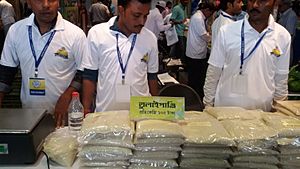Tulaipanji facts for kids
Quick facts for kids Tulaipanji Rice |
|
|---|---|
| Geographical indication | |

Tulaipanji rice being sold by Sufal Bangla at Bangiya Khadya Utsav 2015
|
|
| Alternative names | তুলাইপাঞ্জি চাল |
| Description | Tulaipanji is a aromatic rice cultivated in West Bengal |
| Type | West Bengal aromatic rice |
| Area | Raiganj subdivision of North Dinajpur district |
| Country | India |
| Registered | 24 october, 2017 |
Tulaipanji (Bengali: তুলাইপাঞ্জি) is a special type of rice grown in West Bengal, India. It's known for its lovely smell and is mostly grown in the Raiganj subdivision of North Dinajpur district, and a bit in Dakshin Dinajpur district. This rice is native to the area, meaning it has grown there naturally for a long time. In 2012, the government of West Bengal even sent Tulaipanji rice to a food festival at the London Olympics!
The unique smell and good quality of Tulaipanji rice come from the specific place where it grows. It's a type of fragrant rice, but it's different from Basmati rice.
What Makes Tulaipanji Rice Special?
Tulaipanji rice has medium-long, thin grains, usually about 5.5 millimeters long. When cooked, the rice is very tasty. It has a good texture and looks bright. It doesn't stick together, which means the grains stay separate and fluffy. This is because it has a lot of something called amylose.
This rice is also known for being strong against diseases and pests. This means farmers don't need to use as many chemicals to protect it.
Cooking with Tulaipanji
When Tulaipanji rice is cooked, it turns a whitish-yellow color. The grains stay separate and taste great. It's an excellent choice for making dishes like pulao, fried rice, and biryani.
How Tulaipanji Rice is Grown
Farmers traditionally grow Tulaipanji rice without using any chemical fertilizers. It grows best in fields that are not too low or too high, often in places where jute plants were grown before. This usually happens after the rainy season, from August to December.
The soil in these growing areas often doesn't have a lot of nutrients and can be a bit dry. Experts believe that these conditions are actually what help give the rice its special smell. Farmers usually avoid using chemical fertilizers because they can make the rice lose its natural aroma and other good qualities.
| What it's like | How much |
|---|---|
| Grain length | 5.2 mm |
| Grain width | 1.8 mm |
| Grain type | Medium thin |
| Grain color | White |
| Aroma | Medium (a nice smell) |

